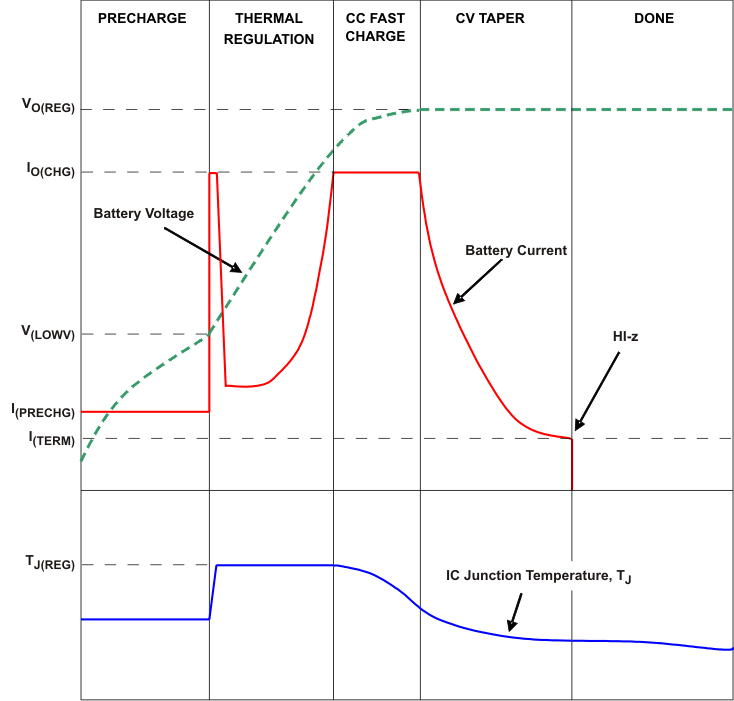ZHCSIF0N September 2008 – October 2021 BQ24072 , BQ24073 , BQ24074 , BQ24075 , BQ24079
PRODUCTION DATA
- 1 特性
- 2 应用
- 3 说明
- 4 Revision History
- 5 说明(续)
- 6 Device Comparison Table
- 7 Pin Configuration and Functions
- 8 Specifications
-
9 Detailed Description
- 9.1 Overview
- 9.2 Functional Block Diagram
- 9.3
Feature Description
- 9.3.1 Undervoltage Lockout (UVLO)
- 9.3.2 Power On
- 9.3.3 Overvoltage Protection (OVP)
- 9.3.4 Dynamic Power Path Management
- 9.3.5
Battery Charging
- 9.3.5.1 Charge Current Translator
- 9.3.5.2 Adjustable Termination Threshold (ITERM Input, BQ24074)
- 9.3.5.3 Termination Disable (TD Input, BQ24072, BQ24073)
- 9.3.5.4 Battery Detection and Recharge
- 9.3.5.5 Battery Disconnect (SYSOFF Input, BQ24075, BQ24079)
- 9.3.5.6 Dynamic Charge Timers (TMR Input)
- 9.3.5.7 Status Indicators ( PGOOD, CHG)
- 9.3.5.8 Thermal Regulation and Thermal Shutdown
- 9.3.6 Battery Pack Temperature Monitoring
- 9.4 Device Functional Modes
-
10Application and Implementation
- 10.1 Application Information
- 10.2 Typical Application
- 10.3 System Examples
- 11Power Supply Recommendations
- 12Layout
- 13Device and Documentation Support
- 14Mechanical, Packaging, and Orderable Information
9.3.5.8 Thermal Regulation and Thermal Shutdown
The BQ2407x contain a thermal regulation loop that monitors the die temperature. If the temperature exceeds TJ(REG), the device automatically reduces the charging current to prevent the die temperature from increasing further. In some cases, the die temperature continues to rise despite the operation of the thermal loop, particularly under high VIN and heavy OUT system load conditions. Under these conditions, if the die temperature increases to TJ(OFF), the input FET Q1 is turned OFF. FET Q2 is turned ON to ensure that the battery still powers the load on OUT. Once the device die temperature cools by TJ(OFF-HYS), the input FET Q1 is turned on and the device returns to thermal regulation. Continuous overtemperature conditions result in a "hiccup" mode. During thermal regulation, the safety timers are slowed down proportionately to the reduction in current limit.
Note that this feature monitors the die temperature of the BQ2407x. This is not synonymous with ambient temperature. Self heating exists due to the power dissipated in the IC because of the linear nature of the battery charging algorithm and the LDO associated with OUT. A modified charge cycle with the thermal loop active is shown in Figure 9-8. Battery termination is disabled during thermal regulation.
 Figure 9-8 Charge Cycle Modified by Thermal Loop
Figure 9-8 Charge Cycle Modified by Thermal Loop